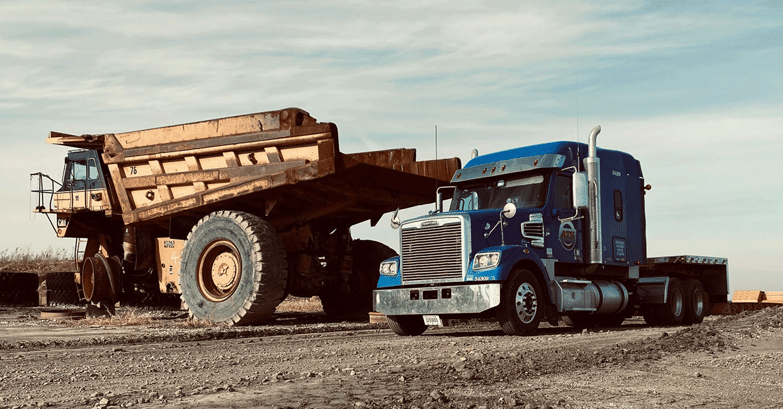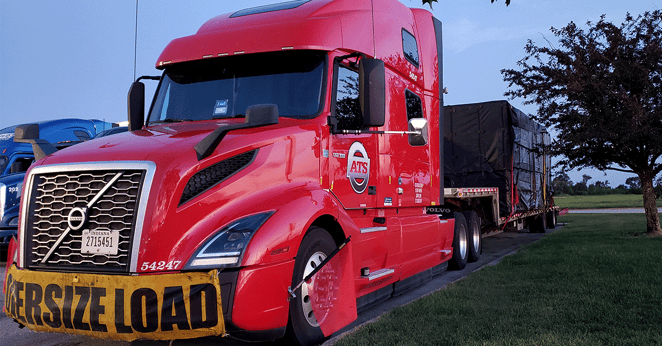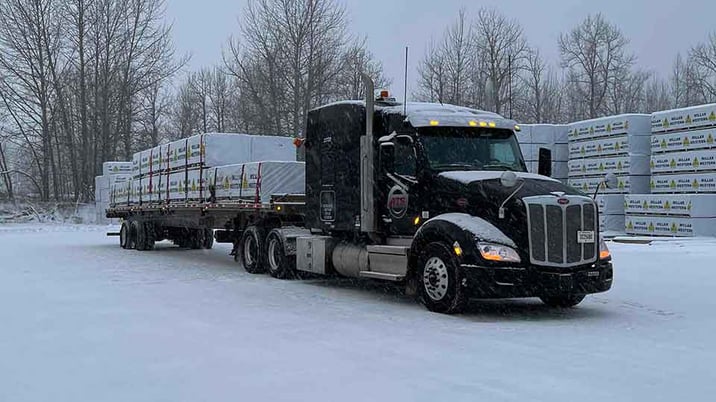
January is seen as the “reset” month for the trucking industry. After the fast-paced holiday shipping season, freight activity slows down, giving carriers and shippers time to recalibrate.
This pause can feel like a welcome breather, but it also introduces new challenges, from reduced freight volumes to unpredictable weather.
Understanding the trucking industry trends in January helps both carriers and customers prepare for what’s ahead. While demand cools, this period also offers valuable opportunities to strengthen relationships, optimize routes, and manage costs before spring shipping ramps up again.
After more than 70 years in the transportation industry, Anderson Trucking Service (ATS) is well-versed in the annual fluctuations of the freight market.
In this article, we’ll tell you what to expect from the trucking industry this January, so you can walk away with all the information you need to have a successful month and a strong start to the year.
Key Takeaways for Shippers:
- Freight volumes tend to dip after peak season, but this will vary by region.
- Winter weather increases transit times, safety risks, and threat of delays.
- Rates and capacity stabilize a bit before spring rebounds.
- Strategic planning and flexible scheduling help keep shipments on track.
Freight Demand in January: Seize Opportunity in the Slow-Down
Freight demand in January typically dips compared to the peak months of November and December.
As a new year begins, consumers are recovering from the busy holiday shopping season, and construction and harvest are drastically slowed, especially in the northern U.S.
Retail and e-commerce shipments decline, but essential goods, construction materials in warmer regions, and agricultural freight continue to move steadily.
The seasonal slow-down typically lasts until March, give or take a few weeks to account for the variable timing of the spring thaw in the north. (More on the impact of weather in a bit!)
While the January trucking slowdown may seem like a lull, it’s actually a strategic window to get ahead. For shippers, this slower period can be a chance to:
- Negotiate better rates
- Test new logistics providers
- Reassess your shipping strategies
- Update schedules
- Lock in dependable capacity for the year to come
For carriers, it’s a time to rebalance networks and focus on asset utilization. Trucking companies that maintain flexibility in their operations have an opportunity to find new efficiencies during this transition.

January Truck Capacity & Pricing Trends
Capacity tends to open up in January as demand for trucks dips. This easing of demand means pricing stabilizes — though regional variation remains high.
In areas affected by winter freight shipping challenges, like the Midwest and Northeast, rates can spike temporarily as adverse weather tightens supply.
Trailer type will also inform your experience seeking capacity. For example, November through March is "freeze protection season," also called “protect-from-freeze season.” Certain goods are adversely affected by freezing and require additional protection from the elements during this period.
Demand for refrigerated "reefer" trailers, usually lower in January, therefore increases in regions where they're needed to keep sensitive goods in consistent, above-freezing temperatures.
Meanwhile, if you have open-deck freight to move in the colder states this month, expect to pay a bit more, especially if your load needs tarps.
Throwing and securing heavy tarps is challenging for drivers even in the best conditions, to say nothing of the freezing temperatures, high winds, snow, and ice they can encounter in northern states during this time.
To avoid unnecessary price hikes, consider designating a sheltered area for truck drivers to use during tarping. In colder climates, the easier you can make it for drivers to service your freight, the better off you’ll be in January.
Related: 6 Tactics for Transporting Freight in Winter

How Winter Weather Impacts Shipping Operations
No discussion of January trucking trends would be complete without addressing winter weather.
Snow, ice, and subzero temperatures affect everything from travel time to fuel efficiency. Drivers must navigate shorter daylight hours, slick roads, and increased safety risks, which can extend transit times and reduce available capacity.
This is especially true for open-deck and oversized shipments. While all types of shipments can be delayed by the challenges of winter weather, the additional complexities of moving flatbed and over-dimensional (OD) freight make them especially susceptible.
We've already touched on how open-deck and reefer freight can be affected by below-freezing temps, ice, and snow, so let's talk a bit about OD loads now.
OD freight already requires permits to move safely, because transportation of oversize goods carries an inherent safety risk. So, when ice, snow, or wind makes navigation difficult and roads hard to visualize, OD freight is understandably the first to be restricted.
If you’re a shipper of oversized goods, this may mean your supply chain will slow down in kind.
Smart logistics teams account for these conditions early. Contingency planning, real-time communication, and proactive tracking are key to minimizing the ripple effects of weather-related slowdowns.
By setting realistic expectations for your January freight movement in collaboration with all stakeholders, you’ll set yourself up for greater success in the weeks to come.
Get the Most From Your Supply Chain This January
As the weather changes and the days begin to lengthen again (finally!), you’ll want to be prepared for everything January may throw at you.
To the best of your ability, try to plan around New Year’s Day (Jan. 1) and Martin Luther King Jr. Day (Jan. 20).
Both of these national holidays slow (or outright halt) the movement of trucks, and many businesses will be closed. (And yes, that means their receiving operations won’t be staffed, so don’t schedule pick-ups or deliveries on those days!)
By scheduling strategically around these holidays, you’ll avoid paying the price-hikes associated with asking a driver to sit on your load for longer than necessary.
Ultimately, a successful January requires flexible appointment scheduling and clear, consistent communication.
So, as the coming year kicks off with a bang, make sure to:
1. Be Less Picky About Pick-Up Times
As trucking companies get back into the swing of things after the December holidays, the ever-increasing pace of business can make it a bit more difficult for carriers to meet rigid pick-up and delivery time requirements.
During this period, allowing your providers some flexibility in their appointment times will help you secure truck capacity more reliably. This is particularly helpful on the pick-up side of your transportation supply chain.
More specifically, providing a two-day window for pick-up will let your provider look beyond trucks in the immediate vicinity.
Their pool of options expands, thereby making capacity easier to secure — and often lowering your costs in the process.
If the recommended two-day window is too broad for your supply chain to support, offering as much flexibility as you can will still go a long way with your carriers.
Even a simple shift from, say, a strict 8 a.m. appointment time to an appointment window of 7-11 a.m. can make it easier for your provider to find the best-fit driver for the job.
In the end, supply and demand are prime price-driving factors. If you can give your freight carriers the time to ensure their supply can meet your demand most efficiently and effectively, you’ll save money and enjoy better service, too.
Related: 5 Tactics For Avoiding Transportation Delays This Winter

2. Be Specific
Many people set New Year’s resolutions to learn new skills, practice old hobbies, or change their lifestyle — so January is a fitting time for shippers to commit to clear, detailed communication with their carriers.
Specifics are everything in the transportation industry. Communication is a powerful tool in any shipper’s tool belt, especially where your transportation supply chain is concerned.
Even seemingly small differences between the specs provided to the carrier and the product the driver actually loads onto their truck can cause major delays, an increased risk of damage, and additional costs.
Miscommunications and mistakes happen, but they don’t have to. By giving your carrier a comprehensive breakdown of load details for your shipment, you’ll safeguard your company against losses and delays.
When sourcing for transportation capacity, clearly state load specifics like:
- Weight (In pounds or tons)
- Dimensions (Length x width x height)
- Commodity specifics
- Pick up location, date, and time
- Names and information of all shipper and consignee contacts
- Drop-off location, date, and time
- Required equipment type
- Any special instructions for your driver, such as:
- Parking instructions
- Tarping requirements, if any
- Which side of the building to enter on
- Information on multiple stops
This information helps the companies vying for your freight gauge their ability to do so effectively — and disqualify themselves if they can’t.
In turn, you’ll save time vetting carriers for your freight and see fewer delays due to lack of specifics.
Stay Productive and Profitable in 2026
January may bring unique challenges, but it also offers opportunities for freight shippers who plan strategically and communicate effectively.
Whether you're navigating seasonal capacity fluctuations in the dry van or reefer markets, preparing for open-deck or over-dimensional shipments, or optimizing your operations around holiday schedules, a proactive approach can make all the difference.
By staying informed, offering flexibility, and prioritizing clear communication, you’ll set your business up to be productive and profitable in Q1 2026 and beyond.
Ready to make the most of 2026? Get this year's Freight Shipping Calendar! This free downloadable calendar tells you the most cost-effective days to ship your freight, so you can have your most successful year yet.




